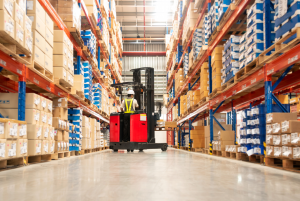Revolutionise Your Warehouse: Storage Solutions For The Future
Warehouses play a pivotal role in ensuring efficient supply chain management. As businesses evolve, so do the demands placed on warehouses. To meet these challenges head-on and enhance operational efficiency, it is crucial for businesses to embrace innovative storage solutions.
Here we explore some of the cutting-edge storage technologies and strategies that can revolutionise your warehouse, paving the way for more streamlined and future-proof operations.
Automated storage and retrieval systems
One of the most transformative advancements in warehouse storage is the implementation of automated storage and retrieval systems (AS/RS). These systems utilise robotic technology to handle tasks such as palletising, storage, and retrieval of goods with incredible precision and speed.
AS/RS not only maximises storage density but also minimises errors in the picking process, resulting in increased efficiency and reduced labour costs. Investing in AS/RS can significantly elevate your warehouse operations, making it future-proof by keeping pace with the demands of a rapidly changing market.
Vertical space utilisation
Vertical carousels, automated vertical lifts, and high-density racking systems allow businesses to make the most of their available space.
By stacking products vertically, warehouses can maximise storage capacity without expanding horizontally or into new premises, making it a sustainable and cost-effective solution for the future.
Efficient vertical space utilisation not only enhances storage capacity but also contributes to a more organised and accessible warehouse layout.
IoT-enabled smart warehousing
The Internet of Things (IoT) has permeated various industries, and warehousing is no exception. Smart warehousing leverages IoT technologies to connect devices and systems, providing real-time data and insights.
Radio-frequency identification (RFID) tags, sensors, and smart tracking systems enable businesses to monitor inventory levels, track the movement of goods, and optimise storage conditions.
Implementing IoT in your warehouse not only enhances visibility and control but also enables predictive analytics, allowing for proactive decision-making and minimising the risk of disruptions.
Flexible and modular storage systems
The ability to adapt quickly to changing market demands is a key characteristic of successful businesses. Flexible and modular storage systems offer a versatile solution for warehouses that need to accommodate a diverse range of products and operational requirements.
Mobile racking systems, adjustable shelving, and modular storage units can be easily reconfigured to accommodate varying inventory sizes and shapes. This adaptability not only future-proofs your warehouse but also provides a cost-effective solution that evolves as your business grows.
Robotics and collaborative automation
The integration of robotics and collaborative automation in warehouse operations is transforming the way goods are handled and moved. Autonomous Mobile Robots (AMRs) work alongside warehouse staff, automating routine tasks such as picking, packing, and transporting goods.
Collaborative automation not only increases efficiency but also improves the overall safety and well-being of warehouse workers. Embracing robotics in your warehouse enhances speed and accuracy, ensuring that your storage and retrieval processes are efficient and scalable for future growth.
Upgrade your warehouse storage solutions
Revolutionising your warehouse with innovative storage solutions is more than just an investment in technology; it is a strategic decision to stay competitive in an ever-evolving business landscape.
Embracing technologies is a step towards building a future-ready warehouse. By staying ahead of the curve and leveraging these advancements, your warehouse can become a hub of efficiency, adaptability, and sustainability in the years to come.
For more advice on making improvements to your warehouse, get in touch with Logical Storage Solutions. Our expert team are on hand to find a solution to any storage problem, so call us on 0845 689 1300, or email [email protected].
Offering a consultative approach and nationwide service for all single and multi-site operations, we are your one-stop provider of all storage, workspace and maintenance solutions.








 Facebook
Facebook Twitter
Twitter LinkedIn
LinkedIn